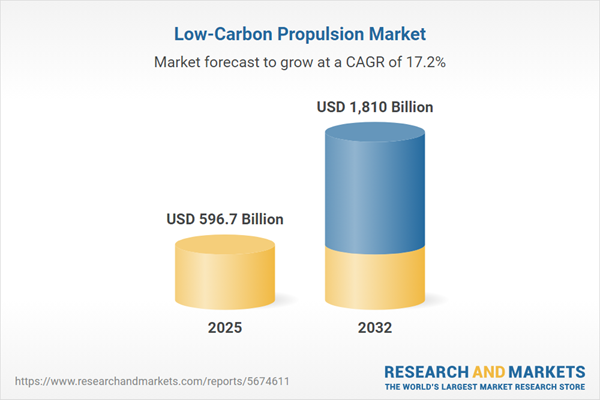Speak directly to the analyst to clarify any post sales queries you may have.
The low-carbon propulsion market is poised for strong growth as global transportation undergoes a systematic shift toward sustainability. Senior leaders now face strategic decisions shaped by evolving value chains, disruptive technologies, and intensifying regulatory requirements.
Market Snapshot: Low-Carbon Propulsion Market
The Low-Carbon Propulsion Market grew from USD 510.55 billion in 2024 to USD 596.70 billion in 2025. It is expected to continue growing at a CAGR of 17.16%, reaching USD 1.81 trillion by 2032. This expansion signals increasing demand for sustainable transport alternatives as emissions-reduction imperatives align with technological advances, policy changes, and new customer preferences.
Scope & Segmentation
This report provides a granular examination of the low-carbon propulsion ecosystem, covering critical technologies, market players, and regional developments. Key segmentation areas include:
- Propulsion Technology: Battery Electric Vehicles, Fuel Cell Electric Vehicles, Hybrid Electric Vehicles, Plug-In Hybrid Electric Vehicles
- Vehicle Type: Bus, Commercial Vehicle, Passenger Car, Two-Wheeler
- Fuel Type: Biofuel, Electricity, Hydrogen, Synthetic Fuel
- Application: Aviation, Marine, Off-Road (Agriculture, Construction, Mining), On-Road
- Component: Battery Pack, Electric Motor, Fuel Cell System, Power Electronics
- Infrastructure: Charging Station (AC Charging, DC Fast Charging), Hydrogen Refueling Station (High Pressure, Low Pressure)
- Regions & Countries: Americas (including United States, Canada, Mexico, Brazil, Argentina, Chile, Colombia, Peru), Europe, Middle East & Africa (including United Kingdom, Germany, France, Russia, Italy, Spain, Netherlands, Sweden, Poland, Switzerland, United Arab Emirates, Saudi Arabia, Qatar, Turkey, Israel, South Africa, Nigeria, Egypt, Kenya), Asia-Pacific (including China, India, Japan, Australia, South Korea, Indonesia, Thailand, Malaysia, Singapore, Taiwan)
- Key Companies: Tesla, Inc., BYD Company Limited, SAIC Motor Corporation Limited, Volkswagen Aktiengesellschaft, General Motors Company, Hyundai Motor Company, Stellantis N.V., Bayerische Motoren Werke Aktiengesellschaft, Mercedes-Benz Group AG, Ford Motor Company
Key Takeaways for Senior Decision-Makers
- Investment in low-carbon mobility is realigning transportation industry value chains, with both traditional manufacturers and new entrants accelerating innovation and collaboration.
- Policy incentives, regulatory mandates, and shifting consumer sentiment are converging to drive rapid adoption across passenger, commercial, and specialty vehicle segments.
- Electrification now encompasses a broad range of applications, from mass-market vehicles to aviation and marine, enabled by developments in battery, hydrogen, and hybrid systems.
- Strategic partnerships are forming between automakers, technology providers, and infrastructure developers to bolster resilience, speed time to market, and drive cost efficiencies.
- Digital tools and analytics are increasingly central to propulsion development, enabling predictive maintenance, real-time fleet optimization, and lifecycle cost management.
- Companies must address supply chain vulnerabilities, focusing on material alternatives, recycling, and localized production to maintain competitiveness in a complex global environment.
Tariff Impact: Implications for Supply Chains and Procurement
Forthcoming United States tariffs present notable challenges for the low-carbon propulsion sector, prompting suppliers to reconsider manufacturing footprints and procurement strategies. Companies are prioritizing domestic partnerships, diversifying sourcing, and re-negotiating long-term contracts to mitigate cost risks and ensure reliable access to critical components. This environment is fueling interest in localizing production and experimenting with domestic raw materials, especially for advanced batteries and fuel cells.
Methodology & Data Sources
Analysis is built on a robust methodology combining a comprehensive review of scientific literature, regulatory materials, and industry reports with direct interviews from senior automotive, energy, and infrastructure executives. Analytical rigor is ensured through triangulated validation and a thorough peer-review process for accuracy and practical insight.
Why This Report Matters
- Strategic leaders gain actionable intelligence to inform investment, partnership, and go-to-market decisions in the rapidly evolving low-carbon propulsion sector.
- Robust segmentation and regional differentiation support precise prioritization of market entry, technology development, and regulatory engagement strategies.
- Clarity on emerging supply chain and policy risks enables effective mitigation and proactive response planning.
Conclusion
The low-carbon propulsion market is redefining the future of mobility at a global scale. Effective navigation of this landscape demands focused innovation, cross-sector partnerships, and agile supply chain strategies. Organizations that align with these trends will fortify their competitive position and drive sustainable growth.
Additional Product Information:
- Purchase of this report includes 1 year online access with quarterly updates.
- This report can be updated on request. Please contact our Customer Experience team using the Ask a Question widget on our website.
Table of Contents
3. Executive Summary
4. Market Overview
7. Cumulative Impact of Artificial Intelligence 2025
Companies Mentioned
The companies profiled in this Low-Carbon Propulsion market report include:- Tesla, Inc.
- BYD Company Limited
- SAIC Motor Corporation Limited
- Volkswagen Aktiengesellschaft
- General Motors Company
- Hyundai Motor Company
- Stellantis N.V.
- Bayerische Motoren Werke Aktiengesellschaft
- Mercedes-Benz Group AG
- Ford Motor Company
Table Information
| Report Attribute | Details |
|---|---|
| No. of Pages | 193 |
| Published | October 2025 |
| Forecast Period | 2025 - 2032 |
| Estimated Market Value ( USD | $ 596.7 Billion |
| Forecasted Market Value ( USD | $ 1810 Billion |
| Compound Annual Growth Rate | 17.1% |
| Regions Covered | Global |
| No. of Companies Mentioned | 11 |









